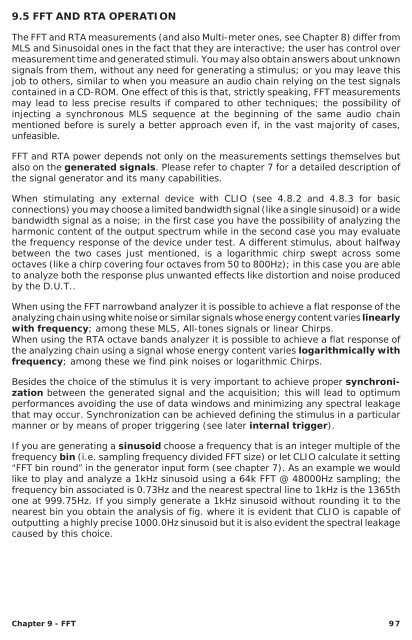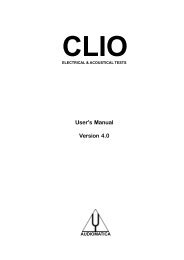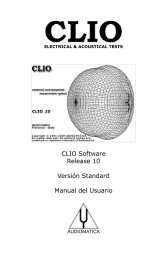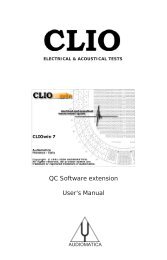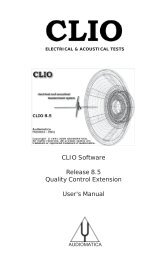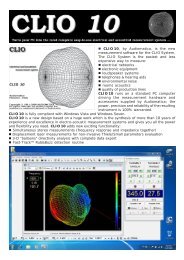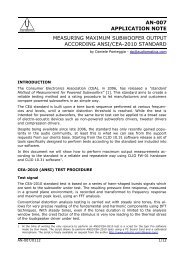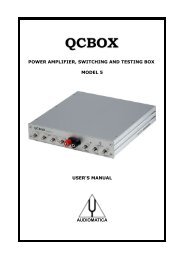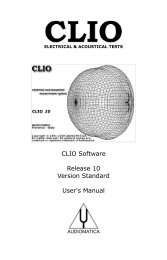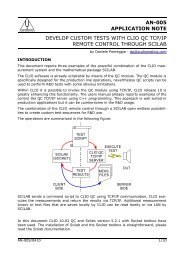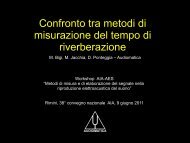CLIOwin 7 PCI User's Manual - Audiomatica
CLIOwin 7 PCI User's Manual - Audiomatica
CLIOwin 7 PCI User's Manual - Audiomatica
Create successful ePaper yourself
Turn your PDF publications into a flip-book with our unique Google optimized e-Paper software.
9.5 FFT AND RTA OPERATION<br />
The FFT and RTA measurements (and also Multi-meter ones, see Chapter 8) differ from<br />
MLS and Sinusoidal ones in the fact that they are interactive; the user has control over<br />
measurement time and generated stimuli. You may also obtain answers about unknown<br />
signals from them, without any need for generating a stimulus; or you may leave this<br />
job to others, similar to when you measure an audio chain relying on the test signals<br />
contained in a CD-ROM. One effect of this is that, strictly speaking, FFT measurements<br />
may lead to less precise results if compared to other techniques; the possibility of<br />
injecting a synchronous MLS sequence at the beginning of the same audio chain<br />
mentioned before is surely a better approach even if, in the vast majority of cases,<br />
unfeasible.<br />
FFT and RTA power depends not only on the measurements settings themselves but<br />
also on the generated signals. Please refer to chapter 7 for a detailed description of<br />
the signal generator and its many capabilities.<br />
When stimulating any external device with CLIO (see 4.8.2 and 4.8.3 for basic<br />
connections) you may choose a limited bandwidth signal (like a single sinusoid) or a wide<br />
bandwidth signal as a noise; in the first case you have the possibility of analyzing the<br />
harmonic content of the output spectrum while in the second case you may evaluate<br />
the frequency response of the device under test. A different stimulus, about halfway<br />
between the two cases just mentioned, is a logarithmic chirp swept across some<br />
octaves (like a chirp covering four octaves from 50 to 800Hz); in this case you are able<br />
to analyze both the response plus unwanted effects like distortion and noise produced<br />
by the D.U.T..<br />
When using the FFT narrowband analyzer it is possible to achieve a flat response of the<br />
analyzing chain using white noise or similar signals whose energy content varies linearly<br />
with frequency; among these MLS, All-tones signals or linear Chirps.<br />
When using the RTA octave bands analyzer it is possible to achieve a flat response of<br />
the analyzing chain using a signal whose energy content varies logarithmically with<br />
frequency; among these we find pink noises or logarithmic Chirps.<br />
Besides the choice of the stimulus it is very important to achieve proper synchronization<br />
between the generated signal and the acquisition; this will lead to optimum<br />
performances avoiding the use of data windows and minimizing any spectral leakage<br />
that may occur. Synchronization can be achieved defining the stimulus in a particular<br />
manner or by means of proper triggering (see later internal trigger).<br />
If you are generating a sinusoid choose a frequency that is an integer multiple of the<br />
frequency bin (i.e. sampling frequency divided FFT size) or let CLIO calculate it setting<br />
“FFT bin round” in the generator input form (see chapter 7). As an example we would<br />
like to play and analyze a 1kHz sinusoid using a 64k FFT @ 48000Hz sampling; the<br />
frequency bin associated is 0.73Hz and the nearest spectral line to 1kHz is the 1365th<br />
one at 999.75Hz. If you simply generate a 1kHz sinusoid without rounding it to the<br />
nearest bin you obtain the analysis of fig. where it is evident that CLIO is capable of<br />
outputting a highly precise 1000.0Hz sinusoid but it is also evident the spectral leakage<br />
caused by this choice.<br />
Chapter 9 - FFT 97


